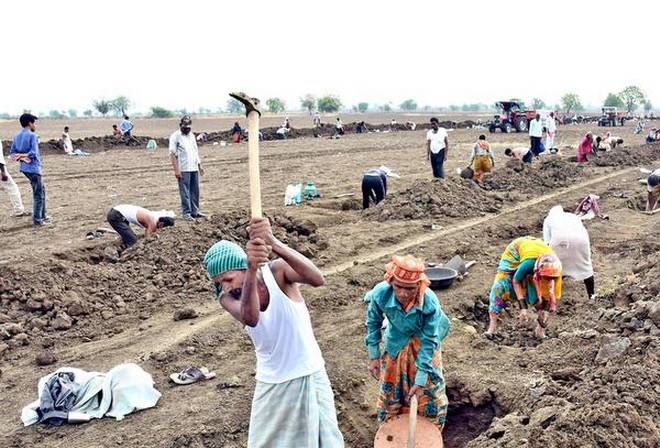Special Correspondent
In some places, however, the rural job guarantee scheme has stemmed exodus
Consecutive years of drought has people in the dry taluks such as Deodurg, Manvi and Lingsugur in Raichur district leaving the villages in droves. Even small and middle farmers in the irrigated belts of Raichur district have migrated as both Narayanpur and Tungabhadra reservoirs are almost dry.

Situation in some belts of southern Karnataka is as bad. For instance, in B.K. Halli in Pavagada taluk of Tumakuru disctrict, about 800 people, of the population of 2,500, have left for Jigani and Peenya industrial areas in Bengaluru in search of work. Those left behind are mostly the elderly and children. Hanumantharayappa, a washerman in the village, said, “When there is no water to drink, where is the question of work for a washerman? My children and relatives have gone to Bengaluru and Tumakuru for work.”
The picture, however, is more heartening in places where Mahatma Gandhi National Rural Employment Guarantee Act (MGNREGA) is implemented better, in Kalaburagi and Bidar districts.
“Over 200 people in Chindanur tanda in Chincholi taluk used to migrate to Hyderabad and other parts of Telangana every year. But this year none has left as they are provided work under the job scheme,” said Sanjeev Pawar, vice-president of the Shadipur Gram Panchayat. At present, 100 people are involved in tank-dredging work alone. These are regions where Janawadi Mahila Sanghatan and other social groups have taken up extensive campaign for creating more demand for work under the scheme.
“We have camped in rural areas, moving from one hamlet to other, spreading awareness about the job scheme. Over 1,500 people have got work in the last fortnight in Chincholi,” said K. Neela, leader of the JMS.
Ballari and Koppal too have witnessed rise in MGNREGA work in places where there is greater awareness about the scheme. For instance, in Ballari district, about 34,000 people worked in 2016–17, as against 15,000 during the previous year.
In contrast, in Raichur district, activists allege procedural issues in the MGNREGA are leading to less job creation. “Earlier, one bank account would do for all the family members having job cards. Now, each member is required to have an account. Bank officials are not cooperating with people coming for opening new accounts,” alleged Vidya Patil, an activist.
“Wherever rural labourers’ organisation is active, people are getting work under the job scheme in view of agitations demanding work. The areas where the organisation has little influence such as Deodurg taluk in Raichur district, people continue to migrate on a large scale,” said Abhay Kumar, leader of the Grameena Koolikarara Sangha.
Farmers in parts of Kalaburagi and Bidar districts, which have seen relatively better rains, are engaging in agricultural activities. These were the only two districts that received more than normal rainfall during the last monsoon.
Even after red-gram crop on around 60,000 hectares of land was lost in the downpour that lashed in September 2016 in Kalaburagi district, the standing crop remained largely unaffected on nearly 4 lakh hectares.
The impact of demonetisation
Most people migrate from Hyderabad Karnataka region — particularly from Shahpur, Surpur, Yadgir, Manvi, Lingsugur, and Deodurg taluks — to be absorbed into the construction industry in Bengaluru, Hyderabad and other metros. However, with construction activities on a downswing after demonetisation, these metros are not pulling the rural labourers like they used to.
Rural labourers and small farmers who used to migrate every year during off-agricultural season are finding it better to work under the job guarantee scheme at a wage of ₹234 a day rather than migrating to distant urban centres for uncertain work.
This apart, since most parts of the State are under the consecutive spells of drought, the demand for farm labourers has dwindled from sugarcane and coffee-growing districts.
As a result, a considerable size of labourers from Hyderabad Karnataka region, who would seasonally migrate to these places, was forced to stay back at their villages finding alternative work.
(With inputs from Kumar Buradikatti in Kalaburagi, S. Bhuvaneshwari in Tumakuru, M. Ahiraj in Ballari, and Ravikumar Naraboli in Yadgir)



